NDVI stands for "Normalized Difference Vegetation Index". NRG stands for "Near-infrared / Red / Green". NDVI and NRG are both ways to visualize the amounts of infrared and other wavelengths of light reflected from vegetation. Because both these methods compare ratios of blue and red light absorbed versus green and IR light reflected, they can be used to evaluate the health of vegetation. It's a snapshot of how much photosynthesis is happening. This is helpful in assessing vegetative health or stress. (Read more here: https://www.agronomy.org/publications/jeq/articles/36/3/832) ## Do-It-Yourself These techniques for vegetation analysis were developed for satellite imagery, but at Public Lab, we've been working a lot on capturing infrared imagery using our DIY [near-infrared camera](/wiki/near-infrared-camera) setup, and combining it with visible bands to produce NDVI images such as the one above. ## What these images mean What exactly are these images we're trying to make? What do they tell us about vegetation, and why? These diagrams should help to understand what it is we're doing and why these are good ways to analyze plant life. ## The NDVI equation [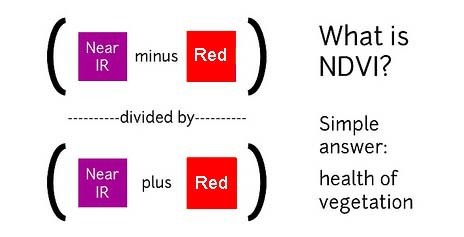](/i/44723) **NDVI = (Near Infrared - Red)/(Near Infrared + Red)** NDVI is a ratio which tries to emphasize photosynthesis while filtering out sun glare. The above equation is run for every pixel, using source data from an infrared photo and a visible light photo, like this pair: [](https://publiclab.org/system/images/photos/000/021/771/original/5390895115_c9d4d38fec_o.jpg) The result can be false-colored to make the high-photosynthesis areas more clear, and used to examine where plants are and how healthy they are. [](https://publiclab.org/system/images/photos/000/021/770/original/PetVISNDVIcomp.png) _Figure above: Normal color photo (right) and normalized difference vegetation index (NDVI) image (left). NDVI image was derived from two color channels in a single photo taken with a camera modified with a special infrared filter. Note that tree trunks, brown grass, and rocks have very low NDVI values because they are not photosynthetic. Healthy plants typically have NDVI values between 0.1 and 0.9. -- @cfastie_ ### Activities Here are a range of activities you can do to produce and interpret your own NDVI imagery, whether downloaded from a satellite imagery provider or [collected yourself using a DIY technique](/wiki/multispectral-imaging) [activities:ndvi] ****   Most DIY converted cameras today (those from Public Lab) use RGN instead of NRG, so the blue channel represents infrared instead of the red channel. That looks like this: [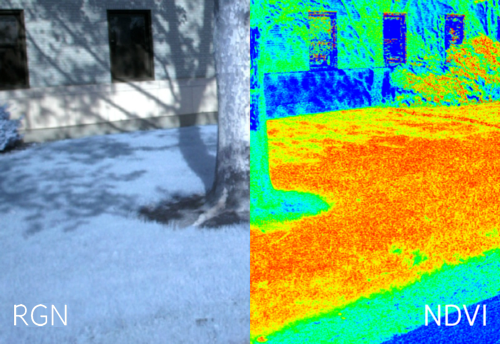](/i/45468?s=o) **** ## NRG imagery Some people are also interested in producing NRG imagery (like the below image), where `Near-Infrared, Red, and Green` are used to compose a picture instead of the usual `Red, Green, and Blue`. [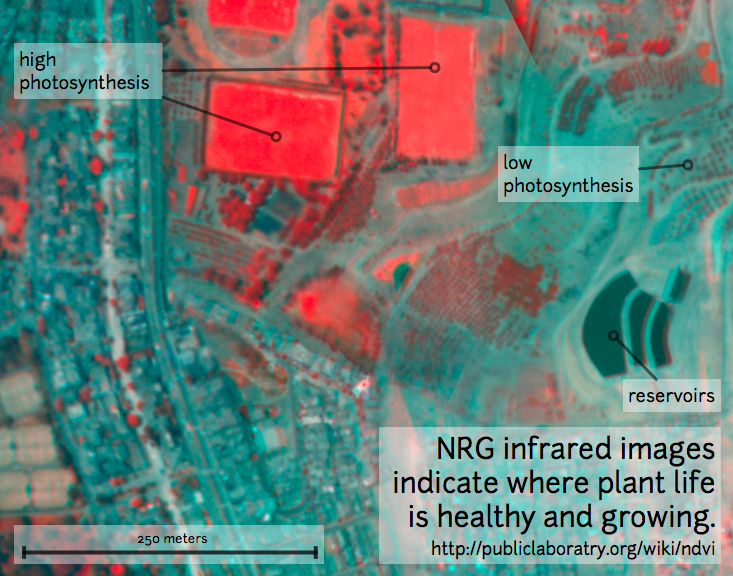](/i/25064) This diagram explains the swapping, which allows us to 'see' infrared as if it were a normal color: [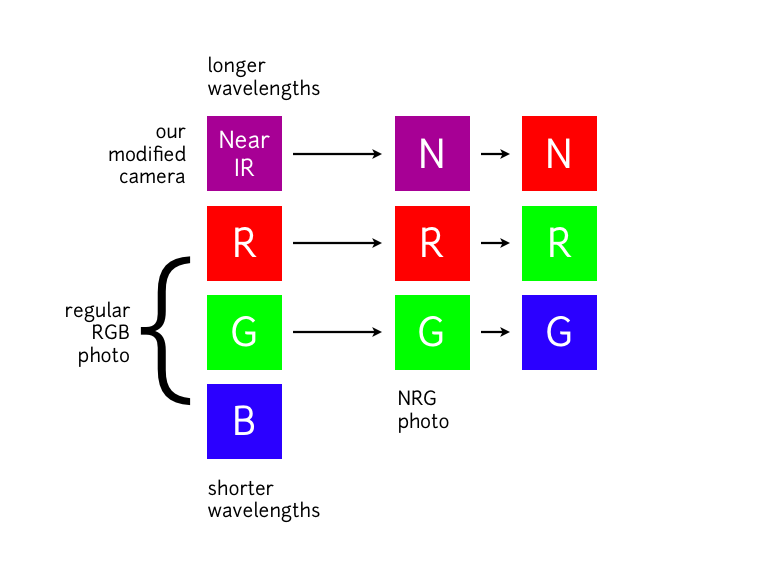](/i/25063) **In NRG images, the deeper and clearer the red color, the denser and healthier the vegetation (more or less).** ### Questions [questions:ndvi] ### Other examples of DIY NDVI imaging From around the internet: Begin watching at 2 minutes to see the resulting imagery: *This topic is part of the [Grassroots Mapping Curriculum](/wiki/mapping-curriculum) series.* **** [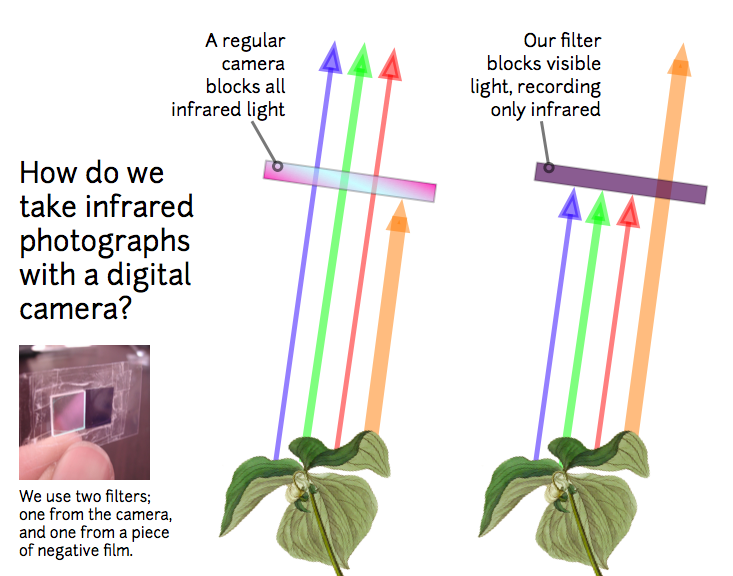](/i/25066) [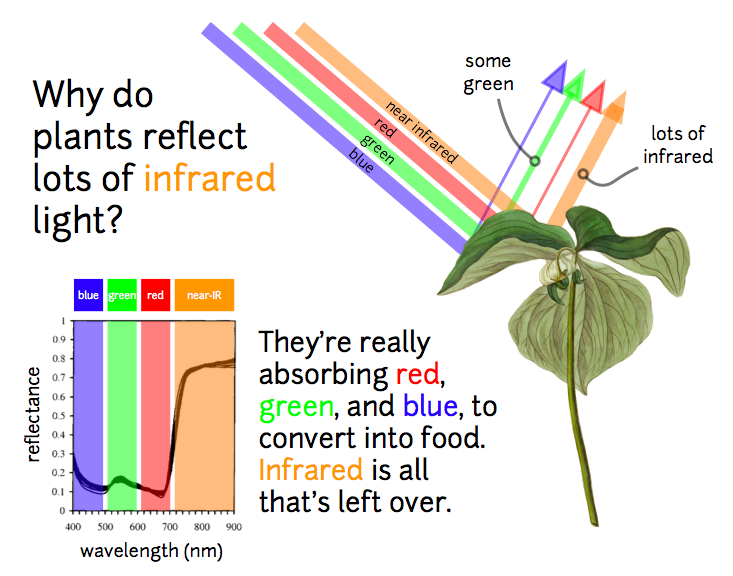](/i/25065) ...
| Author | Comment | Last activity | Moderation | ||
|---|---|---|---|---|---|
| tonyc | ""Graze Anatomy" Groan! What made you use the short pendulum shaft? Just desire to keep it off the ground as much as possible? Or was there somethi..." | Read more » | over 8 years ago | |||
| ggallant | "What a great article!! " | Read more » | over 8 years ago | |||
| cfastie | "Hi Rayishido, They are beautiful mosaics. I didn't have any problem using these images in Fiji. But the Photo Monitoring plugin does not do a very..." | Read more » | over 8 years ago | |||
| Claytonb | "@Gianni_Gadaleta - I never did get the chance to have the Komatex scanned so I haven't used it for target material. Becky Done with SABIC Polymersh..." | Read more » | over 8 years ago | |||
| Rayishido | "VIS " | Read more » | over 8 years ago | |||
| Rayishido | "Hi, Iam back with some update on the project. I didn't tweak the program but I brought the written 87 filter. and put everything on my phantom 2. ..." | Read more » | over 8 years ago | |||
| Gianni_Gadaleta | "Good evening @AFairbairn , I read with great interest your post because even I and my group are having the same difficulties to develop good NDVI i..." | Read more » | over 8 years ago | |||
| cfastie | "There is a discussion of common materials with spectral data in the comments here: https://publiclab.org/notes/LaPa/03-31-2016/raspberry-noir-cam-..." | Read more » | over 8 years ago | |||
| Gianni_Gadaleta | "excellent article Chris. based on your experience you can advise us some targets already spectrally characterized, so we can finally start using th..." | Read more » | over 8 years ago | |||
| cfastie | "You betcha there's research about how mammal grazing and browsing impact carbon and nutrient cycles. A couple of my buddies from graduate school de..." | Read more » | over 8 years ago | |||
| pdhixenbaugh | "Awesome techniques! Is there any research on the guiding assumption that deer have an effect on the amount of carbon sequestered? I would imagine ..." | Read more » | over 8 years ago | |||
| patcoyle | "Chris, Very nice results. Interesting. I love the venison steak in the closing remarks of the video. Pat " | Read more » | over 8 years ago | |||
| Caca_nkg | "Hi guys... Any success with the Phantom??? " | Read more » | over 8 years ago | |||
| balsip | "I'd be fine with a less frequent lapse interval, so 6-min would be fine by me. I see your point about battery life, so this kink might be serendipi..." | Read more » | over 8 years ago | |||
| tonyc | "I used new firmware, which had the ability to do low power mode on any interval over 5mins. I use 6 min interval, to be safe, and it allows camera..." | Read more » | over 8 years ago | |||
| warren | "Hmm, @tonyc was just doing this and I think I remember hearing that there may have been changes to the firmware? @tonyc, any suggestions? " | Read more » | over 8 years ago | |||
| cfastie | "I like #4 too. I don't have a good answer for the type of glue. Something thick and quick drying. It does not have to be sticky, it just has to for..." | Read more » | over 8 years ago | |||
| talha | "Thank you very much for your quick and informative answer, Mr. Chris. Among those choices, which one do you suggest? To me, #4 looks ideal (light c..." | Read more » | over 8 years ago | |||
| cfastie | "The new filter can be put several different places: stick it on the front of the lens. Build a frame to hold it in front of the lens: https://pub..." | Read more » | over 8 years ago | |||
| talha | "I'm getting crazy, there is massive amount of talk about mobius conversions but there is no single guidance for converting the mobius for ndvi. I'v..." | Read more » | over 8 years ago | |||
| Matthew318 | "Using a heat gun allowed a clean removal of the filter, much easier than smashing. Would recommend just getting a $20 heat gun from home depot. " | Read more » | over 8 years ago | |||
| Claytonb | "@AFairbairn - I spent quite some time searching for reliable and cheap target material for calibrations. I spoke with someone who scanned Rustoleum..." | Read more » | almost 9 years ago | |||
| cfastie | "This is a good example of how the spectrum of incident light influences the NDVI of a scene. Leaves reflect about 10 times more NIR than red, but i..." | Read more » | almost 9 years ago | |||
| aldehyde | " I used of Mobius infragam cam (red filter) in Grow Chamber. Light - RED and BLUE (3:1) LED. As I understand this is due to lack of NIR and lot ..." | Read more » | almost 9 years ago |